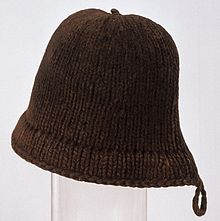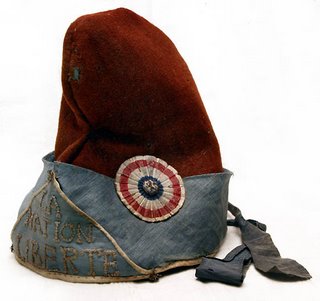No Products in the Cart
When you think of an alpaca hat or knit wool beanie, you might not realize that this essential bit of winter clothing has been around for a long time. How long? How about 27,000 years?
Early Caps
The discovery of primitive weaving impressions in clay fragments of that era have caused archaeologists to believe that the elaborate plaiting on various Venus statues from Neolothic Europe are not elaborate hairstyles, but rather textile caps. The most famous of these fertility fetishes, the Venus of Willendorf, sports only one of the various designs depicted on these statues.

Venus of Willendorf, Germany, 25,000-28,000 BC
It’s certain that warm winter hats made of animal skins, felted wool and woven cloth never went out of fashion from that time forward, but we see one of the oldest examples of an actual knit cap in Western China’s Xinjiang province, dating from around 3000 years ago. This woolen cap was made with a knitting technique called nalbinding, which used shorts lengths of yarn and only one needle. Its resemblance to a modern knit cap is astonishing.
Knit cap made with nalbinding, Xinjiang Province, China, ca. 1000 BC
Nalbinding continued to be used to make hats and socks in Egypt and Scandinavia, and much Viking clothing was fashioned with this technique.
The Huari and Tihuanaco cultures of present-day Peru and Bolivia made gorgeous four-cornered hats in the years between 600 and 900 AD, and you can still see some of these designs in modern-day chullo hats and alpaca beanies at Invisible World.

Huari Four-Cornered Hat, Peru ca. 700 AD
From the 15th to the 18th Century, the English Monmouth Cap was an essential wardrobe element for every British soldier, seafarer or workingman. Named for the area of England where they originated in the 13th century, sailors wore them on their long lonely watch shifts, giving them the name “watch caps.” Simple and solid-colored, an act of parliament not only required them to be worn on Sundays by every person over the age of six, but also required that the hats be domestically made: a strike against imported hats that puts today’s trade wars in context.

Monmouth Cap, England, 16th Century
Why is There a Beanie on the Seal of the US Senate?
Here’s where it gets interesting. In Roman times, freed slaves were given a felt or leather peaked cap called a pileus, which indicated both their liberty and (for men) their right to vote. The hat became associated with liberty and Republican government.

Phrygian Hat, 2nd Century AD
Fast forward to the 18th century, when Republican revolutionary movement across Europe confused the pileus with the similarly-shaped Phrygian cap and adopted it as their symbol of revolution. This was nowhere more pronounced than revolutionary France, where it became such a powerful symbol of the revolution that during the Reign of Terror King Louis the 16th and other nobles and moderates wore them to try show their solidarity with the revolution, and so avoid execution. Elaborately constructed hats gave way to knitted versions that could be provided to the masses, and for those who read Dickens’ A Tale of Two Cities and remember Madame Defarge’s ceaseless knitting beside the guillotine, it was liberty caps that she was so busily turning out.

Liberty Cap Made of Fabric, ca 1790
The symbolism lasted: you can see the knit version of the Liberty cap on the seal of the United States Senate, as well as the flags or seals of New York, New Jersey, Iowa, North Carolina, Virginia, Argentina, Bolivia, Cuba and many more countries. The cap often appears on the spear, an image drawn from Appian’s recounting of the assassination of Julius Caesar and symbolizing the violent overthrow of tyranny.

Seal of the United States Senate, 1886-current
Toboggans: Why is a knit hat named after a sled?
For those in the Southeast United States, calling a wool beanie a “toboggan” is probably second nature, but for the rest of us, it’s puzzling. For us northerners, of course, a toboggan is a long wooden sled with a curved front. This Algonquian word had been adopted by French Canadians, and those who used toboggans for transport tended to wear warm woolen caps, called a toboggan hat. Eventually, in the south, the word “hat” disappeared, and the term toboggan remained to indicate a knit woolen. In Canada, the same hat is now called a toque.
SEE OUR CASHMERE AND ALPACA HATS